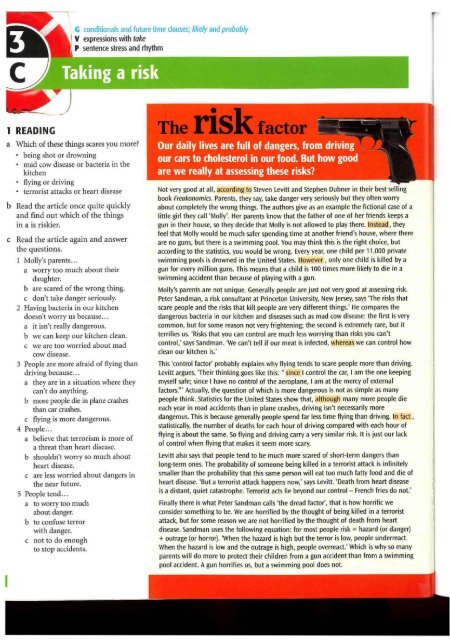Upper-intermediat 5tudenf Book
Create successful ePaper yourself
Turn your PDF publications into a flip-book with our unique Google optimized e-Paper software.
G conditionals and future time clauses; likely and probably<br />
V expressions with take<br />
P sentence stress and rhythm<br />
1 READING<br />
a Which of these things scares you more?<br />
being shot or drowning<br />
mad cow disease or bacteria in the<br />
kitchen<br />
flying or driving<br />
terrorist attacks or heart disease<br />
b Read the article once quite quickly<br />
and find out which of the things<br />
in a is riskier.<br />
c Read the article again and answer<br />
the questions.<br />
1 Molly's parents ...<br />
a worry too much about their<br />
daughter.<br />
b are scared of the wrong thing.<br />
c don't take danger seriously.<br />
2 Having bacteria in our kitchen<br />
doesn't worry us because ...<br />
a it isn't really dangerous.<br />
b we can keep our kitchen clean.<br />
c we are too worried about mad<br />
cow disease.<br />
3 People are more afraid of flying than<br />
driving because ...<br />
a they are in a situation where they<br />
can't do anything.<br />
b more people die in plane crashes<br />
than car crashes.<br />
c flying is more dangerous.<br />
4 People ...<br />
a believe that terrorism is more of<br />
a threat than heart disease.<br />
b shouldn't worry so much about<br />
heart disease.<br />
c are less worried about dangers in<br />
the near future.<br />
S People tend ...<br />
a to worry too much<br />
about danger.<br />
b to confuse terror<br />
with danger.<br />
c not to do enough<br />
to stop accidents.<br />
Not very good at all, according to Steven Levitt and Stephen Dubner in their best selling<br />
book Freakonomics. Parents, they say, take danger very seriously but they often worry<br />
about completely the wrong things. The authors give as an example the fidional case of a<br />
little girl they ca ll 'Molly'. Her parents know that the father of one of her friends keeps a<br />
gun in their house, so they decide that Molly is not allowed to play there. Instead , they<br />
feel that Molly would be much safer spending time at another friend 's house, where there<br />
are no guns, but there is a swimming pool. You may think this is the right choice, but<br />
according to the statistics, you would be wrong. Every year, one child per 11 ,000 private<br />
swimming pools is drowned in the United States. However , on ly one child is killed by a<br />
gun for every million guns. Th is means that a child is 100 times more likely to die in a<br />
swimming accident than because of playing with a gun.<br />
Molly's parents are not unique. Generally people are just not very good at assessing risk.<br />
Peter Sandman, a risk consultant at Princeton University, New Jersey, says 'The risks that<br />
scare people and the risks that kill people are very different things.' He compares the<br />
dangerous baderia in our kitchen and diseases such as mad cow disease: the first is very<br />
common, but for some reason not very frightening; the second is extremely rare, but it<br />
terrifies us. 'Risks that you can control are much less worrying than risks you can't<br />
control,' says Sandman. 'We can't tell if our meat is infeded, whereas we can control how<br />
clean our kitchen is.'<br />
This 'control factor' probably explains why flying tends to scare people more than driving.<br />
Levitt argues, 'Their thinking goes like this: " since I control the car, I am the one keeping<br />
myself safe; since I have no control of the aeroplane, I am at the mercy of external<br />
fadors."' Adually, the question of which is more dangerous is not as simple as many<br />
people think. Statistics for the United States show that, although many more people die<br />
each year in road accidents than in plane crashes, driving isn't necessarily more<br />
dangerous. This is because generally people spend far less time flying than driving. In fad,<br />
statistically, the number of deaths for each hour of driving compared with each hour of<br />
flying is about the same. So flying and driving carry a very similar risk. It is just our lack<br />
of control when flying that makes it seem more scary.<br />
Levitt also says that people tend to be much more scared of short-term dangers than<br />
long-term ones. The probability of someone being killed in a terrorist attack is infinitely<br />
smaller than the probability that this same person will eat too much fatty food and die of<br />
heart disease. 'But a terrorist attack happens now,' says Levitt. 'Death from heart disease<br />
is a distant, quiet catastrophe. Terrorist ads lie beyond our control- French fries do not.'<br />
Finally there is what Peter Sandman ca lls 'the dread fador', that is how horrific we<br />
consider something to be. We are horrified by the thought of being killed in a terrorist<br />
attack, but for some reason we are not horrified by the thought of death from heart<br />
disease. Sandman uses the following equation: for most people risk = hazard (or danger)<br />
+ outrage (or horror). 'When the hazard is high but the terror is low, people underread.<br />
When the hazard is low and the outrage is high, people overread.' Which is why so many<br />
parents will do more to protect their children from a gun accident than from a swimming<br />
pool accident. A gun horrifies us, but a swimming pool does not.


